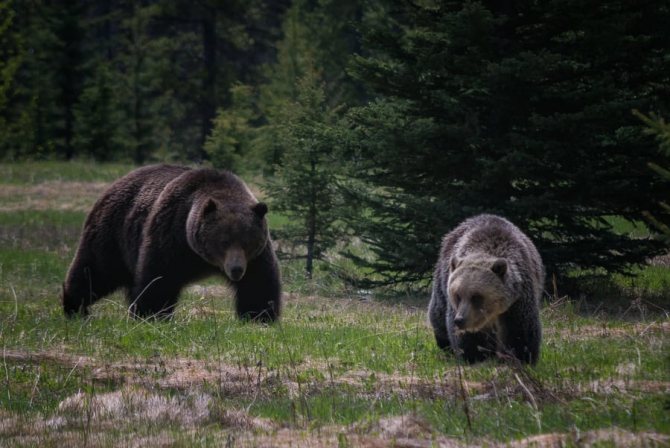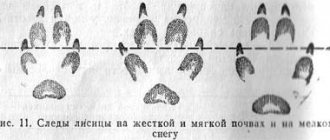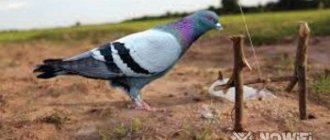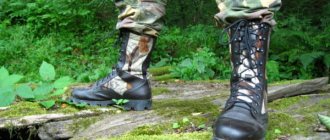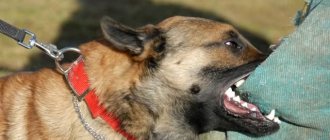- September 6, 2018
- Man in the wild
- Evdokimova Irina
How to scare away a bear in the forest? An encounter with a huge forest predator poses a great danger to humans. The behavior of this animal is often unpredictable; it can attack a person without showing external signs of aggression. How to escape from a bear and make it go away? In this article we will look at different methods of scaring away these animals.
When are bears dangerous?
Bear attacks on humans are rare. Most often, these animals are afraid of humans and avoid close contact with them. Let's consider cases when this predator is especially dangerous:
- If the animal is wounded. A predator experiencing pain becomes very aggressive. Bears are extremely hardy animals. Even a seriously wounded animal can attack a person.
- If you meet a female with cubs. The she-bear perceives humans as a potential threat to her offspring. In this case, the animal may attack even if you do not approach the cubs.
- If there was a collision with a connecting rod bear. Animals awakened from hibernation can be extremely dangerous. Such animals cannot get food for themselves in cold weather and perceive humans as food. Therefore, if you encounter a bear in the forest in winter, you must behave extremely carefully.
What to do when meeting a bear?
If you see a bear, try to get away from it. Give the bear every opportunity to avoid meeting you. If you encounter a bear, remain calm. Attacks are rare. There is a chance that you are not in danger. Most mother bears are interested in protecting their food, their cubs, or their personal space. When the threat is over, they will pass by.
Make yourself known
Let the bear know that you are human. Talk to the bear in a normal voice. Wave your arms. Help the bear recognize you. If the bear cannot recognize who you are, it may come closer or stand on its hind legs to get a better look or sniff. A standing bear usually shows curiosity and is not dangerous. You can try to slowly back away diagonally, but if the bear starts to follow you, stop and stay where you are.
Don't run!
DO NOT RUN under any circumstances. You can't outrun a bear. They have been found to run at speeds of around 60 km/h and, like dogs, they will chase a fleeing animal or person. This animal mistakes an animal running from it for a victim and easily kills in 90% of cases out of 100. Bears often intimidate, intimidate, sometimes 3 meters from their enemy, without trying to attack. Keep waving your arms and talking to the bear. If the bear gets too close, raise your voice and become more aggressive. Knock on pots and pans. Never imitate a bear's growl or scream in a high-pitched voice.
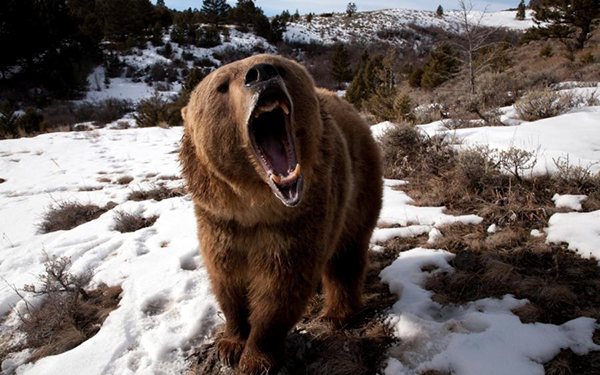
If a bear attacks
If the bear starts to attack, give up! Fall to the ground and play dead. Lie on your stomach or curl up in a ball with your hands behind your head. It is common for a bear to stop attacking if it feels the threat has been eliminated. Stay still for as long as possible. If you move and the bear sees or hears you, he may return and resume the attack. In rare cases, an attacking bear may mistake a person for food.
Peculiarities of animal behavior
Before answering the question: “How to scare away a bear in the forest?”, you need to understand the habits of the predator. When meeting people, this animal can behave differently. There are several types of bear behavior when confronted with a person:
- Predatory. In this case, the bear initially perceives the person as possible prey. The beast either slowly approaches people with its ears raised, or appears suddenly. This behavior is typical for connecting rods left without food.
- Defensive. The beast perceives a person as a potential threat. The animal growls and with its entire appearance shows obvious excitement and aggression. This is a rather dangerous type of behavior that often ends in an attack. Usually mother bears with cubs behave this way when they accidentally meet a person.
- Curious. The bear slowly approaches the person, ears pricked and sniffing. Sometimes the animal stands on its hind legs. This is how animals behave when they smell food. Therefore, experienced hunters do not recommend setting up a food storage area near the tent. This may lure a bear to your site.
- Neighborhood. Bears can live in forests located near populated areas. Such animals get used to people and lose their fear of humans. They can get quite close. However, the outwardly peaceful behavior of the animal should not mislead you. The bear often behaves unpredictably. He may perceive a person as an enemy who has entered his territory. In this case, the animal may attack suddenly.
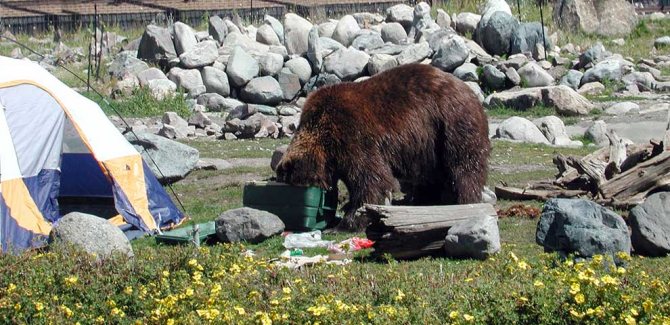
Possible conflicts between a tourist and a bear and how to avoid them
When meeting a bear, several scenarios are possible:
- If you caught him eating prey (this could be berries) or found his prey in the forest, then the probability of attacking you will be approximately 100%. The attack will be sudden and out of nowhere. Nevertheless, you can scare them off with a weapon or a flare, the main thing is to have time to use them.
If you come across a dead animal or a pile of fish in the forest, it is better to immediately turn around and leave the same route you came in, and go around this place at a sufficient distance. When picking berries and mushrooms, avoid sudden encounters, make as much noise as possible so that the bear hears you and leaves.
- A chance encounter with a bear on the trail or on the road, in this situation you will most likely part with him quite peacefully, either leave the trail, or warn him that you are there, since he may not see you, but do not scare him.
- If you camped on his territory or on his road, it’s quite difficult to scare him off, he will walk right through the tent, tear your car and boat apart, if you don’t have a weapon and the opportunity to kill him, the best solution would be to carefully retreat and hide, watching with sadness your camp and your equipment are destroyed, the bear most likely will not attack you unless you provoke it.
We recommend: Fishing and recreation on Lake Velikoye in the Ryazan region
The worst thing is to be in a tent at this moment; unfortunately, there is no advice on what to do in this situation.
When collecting information about the route in advance, find out from other tourists whether there have been bear attacks on tourist camps, if you were careful and attentive, if this problem bear is not killed, then most likely it will be your guest, and it is not particularly afraid of you, in the video below:
- Meeting with a mother bear and cubs, in this situation the main thing is not to scare the cubs, and give the mother the opportunity to take them away. Visually you may not see the bear, but she is there, she is nearby and she is watching you. The worst thing is to find yourself between cubs and a mother bear; there is no advice from survivors on what to do in this situation; in any case, it is important not to provoke the bear to attack, although she has already been provoked.
- Teenage bears come to rob the camp, are easily scared away by loud noise, and are relatively harmless unless accompanied by a female bear.
- A bear may become interested in you out of curiosity; young bears usually do this and are scared away by noise;
- The bear wants to eat you, the situation is unfortunate, unfortunately it is almost impossible to escape, fortunately the situation is extremely rare, since humans are usually not part of the bear’s diet.
To avoid a chance encounter, before leaving, study the area for the presence and behavior of bears in the area; bears behave differently everywhere; how likely is it to encounter them?
Find statistics on bear attacks on people, try to contact the local police officer of the area where you are going, he doesn’t need problems in his area and he will most likely share this information with you.
Based on the information received about the terrain and the characteristics of the bear’s habitat in the area where you are going, during your hike you need to provide and take into account the following:
- Bears do not attack groups of people, move in groups, talk loudly and make noise;
- When moving alone, you need to make a lot of noise, you can turn on the radio, hang a metal mug and a climbing carabiner on your backpack so that they rattle, you can blow a whistle;
- When setting up a camp, it is necessary to inspect the place for the presence of a bear trail. Signs of the trail include rumpled grass, beds in the grass, bear tracks and excrement. Trees may have claw marks. When parking near the water, inspect the shore and the grass nearby for traces and resting places of the bear;
- It is better to cook food 200 meters from the camp, and hang food supplies on trees there. Do not leave fish entrails on the shore of a pond or near your camp. The bear has an excellent sense of smell and can easily come at night or at dusk. Take the cans of stewed meat 100 - 200 meters from the camp, burn and bury them before removing the camp;
- When moving along forest roads, be careful; wild animals also love to walk on roads, the bear is no exception;
- When riding a horse, be aware that a bear may attack the horse.
- Bears are not afraid of fire, so the presence of a fire is not a guarantee of safety. Moreover, in places where forest fires rarely occur, a fire can be a means of scaring bears and other wild animals away from the camp.
- If you smell the strong smell of a dog in the forest, most likely a bear is walking somewhere nearby; in this situation, it is best to stop, start talking loudly, sing songs, and whistle. Most likely the bear will hear you and go about his business, and you won’t even see him. Wait about twenty minutes and you can continue your route.
- If you smell rotten meat or fish, do not go to the source of the smell, warn about your presence and walk around the area.
We recommend: Fishing spots in the Moscow region, Pakhra River, Zelenovsky Omut
What not to do
Very often, people, when faced with a bear, take the wrong actions, which only increase the aggressiveness of the animal. A mistake in such a situation can cost a person his life. When meeting a forest predator, you should never:
- Run away. Bears run much faster than humans. Their movement speed reaches 60 km per hour. The beast will definitely go in pursuit. It is important to remember that forest predators perceive a running person as a potential victim.
- Turn your back to the predator. The bear uses this moment to unexpectedly attack from behind.
- Feed the beast. Often, when a bear approaches, hunters and tourists try to “cajole” it with treats. Under no circumstances should this be done. A fed bear will demand a new portion of food. If he refuses, he may attack a person.
- Imitate bear sounds. Under no circumstances should you imitate the roar of an animal. This will only provoke aggression.
- Show your fear. Often bears will come close to a person to intimidate him. At the same time, animals do not always have the intention of attacking; they simply want to drive away uninvited guests from their territory. But if a person clearly demonstrates his fear, then an attack cannot be avoided.
- Set dogs on the beast. Not every dog can cope with such a large predator. Most often, the bear begins to attack dogs and chase them. Such actions can only provoke the animal’s aggression. Only specially trained dogs trained for bear hunting can stop the attack of the beast.
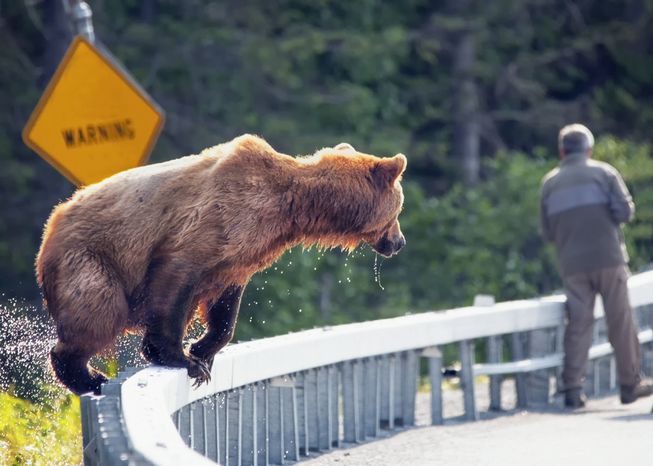
How to scare away a bear if he catches you fishing? This animal will often attack fishermen. Bears may perceive humans as a rival in obtaining food. You must immediately cut the fishing line and leave the fishing spot. You need to move away from the predator slowly, turning to face it and backing away.
Predator attack
When the beast finally left Oleg, he lay motionless for some time. Then I realized: I had to get out, because the bear feeds mainly on carrion and after some time it always returns to its prey. The man, gathering his last strength, stood up. He tried to climb a tree in the hope that the bear would not get him there. He saw nothing, his face was covered in blood. And I felt nothing, the shock was so strong.
“I crawled and crawled,” says Oleg, “then I thought: the bear could easily come up after me... I went back down... I lay there a little more. He cut the backpack off his shoulders with a knife and took off his rubber boots. And in socks he began to make his way to the car left two kilometers from the lake. Then the only desire was to rip off the remains of my face. They got in the way, clinging to branches.
Soon the eyes began to see a little. Oleg got to the car and picked up his mobile phone. The battery ran out, he took out the charger and charged the device. He called his wife and asked him to call an ambulance and find his friends who knew where he had gone fishing. A work colleague who arrived half an hour later found Oleg sitting in the front seat of the car. He was afraid to approach his mutilated and bloodied comrade. Even the ambulance doctors, upon seeing the victim, immediately rushed in all directions.
“When my husband called me, I didn’t know what to do,” says the victim’s wife Svetlana, “then I came in an ambulance with the doctors.” The young nurse’s hands were shaking; I helped apply a tourniquet. Oleg needed five operations and seven donors for blood transfusions. Both of my husband's arms were broken. For several days he was between life and death. And now he will still have to undergo treatment for a long time, and he will have to undergo several plastic surgeries on his face.
Oleg is not the only victim of the man-eating bear. Three weeks ago, in the Lososinny area, a predator attacked a man. The young man, seeing the beast, began to run. The bear caught up with him and grabbed his thigh. Fortunately, the victim managed to escape. The young man was taken to the Petrozavodsk railway hospital. Now the man is already at home. He was much luckier than Oleg, who will not soon return to normal life.
Sound
You can use rocket launchers or bear firecrackers. This method will help if the animal is at a sufficiently large distance from you. The pyrotechnic device must fall between the person and the predator. If a firecracker explodes behind a bear, it may rush at a person out of fear. Pyrotechnics have a double scaring effect; the animal is frightened by both a loud sound and a flash of light.

You can use a pneumatic horn to scare away bears. Just press the button and the device emits a sharp and piercing sound. This product is easy to use and quite effective. In the video below you can see the principle of operation of a pneumatic forge.
The thunder gun is a good sound bear repeller. This is a mechanical or electronic device in the shape of a gun. Liquefied gas burns inside the device, this process is accompanied by loud sounds. A special pipe enhances the sound effect. This product is usually used to scare away birds, but it is also quite applicable when faced with large predators. The radius of action of the thunder gun is about 1 km. This remedy will help drive away the bear, even if it is at a great distance from you.
Light
A flare is suitable for scaring away the animal. This is a signaling device from which, when the string is pulled, a bright torch flies out. It is better to use a red signal. The animals mistake it for fire and run away. In this case, you need to act very quickly. You cannot keep a flare pointed at a bear for a long time. This can only anger the beast.
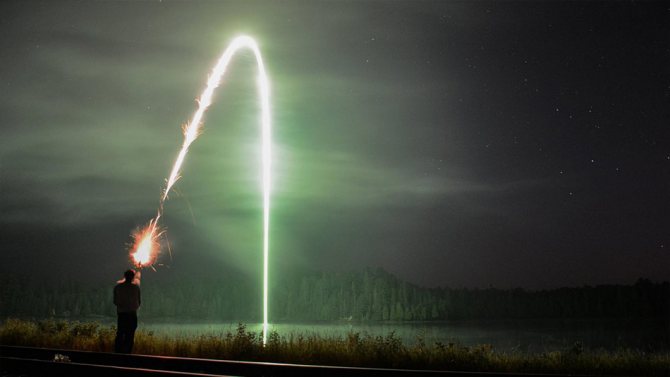
Pepper spray
If the animal comes close to you, you can scare it off with a can of pepper spray. It is important to remember that sprays should not be used against large animals for self-defense against criminals. Products for people contain a small concentration of gas, which is unlikely to affect a huge beast.
Against bears, you need to use special sprays to repel large animals. They can be purchased at hunting stores or online. Tools such as “Anti-Beast” or “Control-AS” are suitable. They contain red pepper extract and have a fiery effect.
Sprays should be sprayed when the bear comes within 5-6 meters of you. You need to act in such a situation extremely quickly and accurately. It is necessary to get the aerosol into the eyes or nose of the animal. In 92% of cases the bear runs away. However, pepper sprays can only be used in calm weather.
The most likely places to encounter a bear
The daily activity of a bear is determined by the season of the year, the availability of food and the general life cycle of the animal. In spring and the first half of summer, bears can feed around the clock, especially in cloudy weather. The bear's high daily activity continues until the start of salmon and grayling migration. For the day, bears lie down without going far from the feeding site, usually in thickets of bushes, in closed clearings, in small forest clumps; on hot days they can be located in floodplain tall grass or river grass.
During the period of mass migration of salmon, daytime activity decreases and shifts to evening, morning and night hours. When there is a lack of food (especially when fish are weak), the activity of bears increases, and they feed in berry fields, in elfin cedar forests or in mountain meadows at almost any time of the day. For rest, the bear usually settles under the canopy of coniferous trees, and the resting places can be used many times. In twilight and in the thicket of a forest, a bear feels much more confident than a person.
The bear is omnivorous. In the Urals in the spring, after leaving their dens, animals go out to the warm slopes of the mountains, which warm up and are quickly freed from snow cover, where they dig for rhizomes and bulbs. Later in May, they begin to go to rivers or berry fields, pick up carrion, and eat the remains of berries. Animals often visit the coasts of rivers and lakes in search of animal and plant waste.
When fish begin their migration to spawn, most bears are located near spawning rivers. On the mountain Ural rivers, fish is the main source of protein food for the animal. After gorging on fish, bears go to berry fields or grasses, only to return to the river after some time. This will diversify the menu and make the diet richer. In the autumn before their bedding (October-November), bears leave the rivers and gradually move, feeding on the berries and nuts of dwarf pine trees, and go to their wintering places.
In their environment, bears are cannibals. A larger bear can catch and eat a cub (which most often happens during the mating season, when the cubs are close to the mother bear). There have been recorded cases of bears attacking and eating smaller (usually young) individuals.
Winter shelters for bears are usually located in the ground or caves. Two or three animals can sleep in one den. If there is an abundance of food, individuals of good fatness may not lie down in dens at all, arranging surface beds - nests.
Humans are not the bear's food source. Most bears under normal conditions try to avoid meeting a person, and, having discovered him first, try to leave unnoticed. If the meeting does occur, then the vast majority of bears take flight. However, you should always remember and clearly know that the behavior of a particular bear that you encounter in a particular situation is UNPREDICTABLE!
Firearms and air weapons
It is important to remember that a gun should only be used as a last resort if there is a real threat of attack. You should not shoot a bear, especially if you are an inexperienced hunter. A wounded animal is extremely aggressive and immediately attacks a person. Therefore, you need to fire shots close to the animal. The animal will get scared and quickly run away.
Experienced hunters recommend using air guns with flash-noise cartridges. When fired, a white flame and a very loud sound are formed. This effect extends over a long distance. Even a very ferocious animal will be afraid of such a powerful influence.
Handy means
How to scare away a bear in the forest without having special equipment? It is necessary to create as much noise as possible. You can shout, whistle, hit the mug against the pot. Any loud sounds will scare the animal. If you go into a forest where there are bears, you need to move around making noise, this will help prevent you from meeting a predator.
If you don’t have special light deterrents on hand, you can light hunting matches. They can burn for a long time. It is necessary to keep the fire within the bear's line of sight.
If you have made a fire, you can throw burning brands towards the beast. It is also recommended to quickly set fire to tree bark, resin or moss. The bear is afraid of fire, like most animals. As a last resort, you can try to scare the predator with a flashlight with a bright light bulb. Usually the bear will show curiosity about the electric light for the first few seconds and then run away.
Bear protection equipment
As we have already written, the best way is to avoid meeting him; be noisy in the forest and you most likely will not meet him.
Recommended: Synthetic or steel winch rope
In most cases, a human voice and scream, the sound of a whistle, a metal clang, and sometimes a shot from a weapon, a flare gun, or a hunter’s signal help scare away a bear. You should not use firecrackers, as fragments fly from them; if they hit a bear, this can provoke an attack.
The hunter's signal rarely helps, the bear does not see the flash, the maximum that can scare it is a clap, but not all bears are afraid of it, since there are many loud sounds in nature.
As many geologists and zoologists who most often come into contact with bears say, the most effective means of scaring off bears is a flare for small vessels, which works effectively at a distance of five meters from the bear.
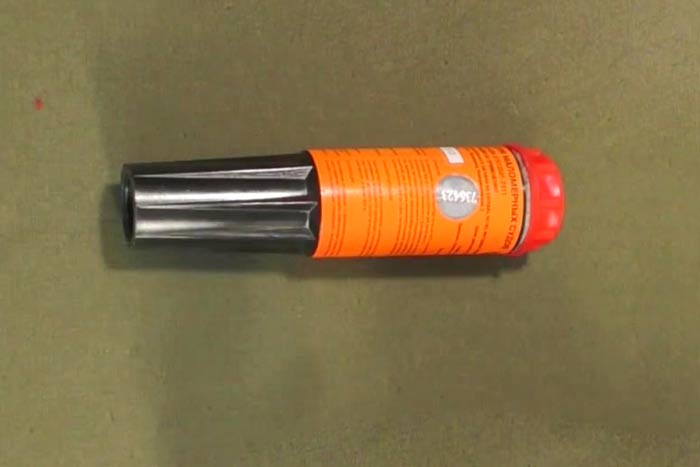
False flares for small vessels
Such popular means as hunter's signals and large pepper spray against bears do not always work. Football flares are not reliable and can easily become damp or wet.
When using a flare, keep in mind that it takes time to get it into working condition , and this time is usually greater than the speed of a bear attack; we recommend preparing it in advance if encounters are possible or you saw a bear.
Weapons against bears
If you are not a professional or experienced hunter, it is better not to use a weapon.
For smooth-bore weapons, 12-gauge weapons and larger, necessarily hollow-bore bullets are suitable.
Rifled carbines calibers:
- .30-06 Sprgn;
- .300 Winchester Magnum;
- .338 Winchester Magnum;
- 9.3×62;
- .375 Holland&Holland.
Smaller calibers require serious shooting skills.
When using a weapon for self-defense against a bear, you need to understand that you need to kill it with the first shot; you most likely will not have a chance to make a second shot, since the bear is already attacking you.
A wounded bear is more dangerous than a live one. Therefore, using weapons requires good hunting, shooting skills and knowledge of the anatomy of the animal. If you don’t have these skills and knowledge, then it’s better not to use weapons.
It should be understood that being with a weapon in the forest without a hunting license makes you a poacher, and killing a bear even for the purpose of self-defense also, with all the ensuing consequences and criminal prosecution. There may be problems with the law if you are caught in the forest with a hunting weapon.
Advice to hunters: if you don’t have a bullet cartridge in the barrel, your weapon is useless , if the bear decides to attack, then most likely you won’t have time to reload, so when going duck hunting, putting a bear bullet cartridge in your pocket or bandoleer does not make sense. Shooting in the air, shouting, clicking a shutter, or using a flare can help scare off a bear.
We recommend watching (Candidate of Biological Sciences, member of the Association for the Study, Use and Conservation of Bears), this article uses materials and data from this lecture.
other methods
As already mentioned, bears are afraid of the unexpected. There have been cases when predators were frightened by a suddenly opened umbrella. This remedy will help if the animal comes close to you. In this case, the umbrella must be opened towards the bear.
Hunters also recommend raising an object above your head, such as a hat or basket. In the eyes of the animal, you will appear taller, and the bear will perceive you as a larger and more powerful opponent. This is a good psychological technique for scaring away the beast.
Can ultrasound serve as a bear repellent? Such emitters are intended primarily for protection against dogs. Manufacturers of ultrasonic devices do not claim effectiveness against large animals. Therefore, it is better not to rely on emitters; in a critical situation, such means may simply not work.
If the bear has already attacked
You can use various bear repellers only before an attack. In this case, there is a chance to drive the animal away. At the same time, it is very important not to block the predator’s escape route. The bear must be able to escape.
What to do if the beast has already attacked a person? Experienced hunters recommend falling and pretending to be dead when attacked by a predator. You cannot move or make even barely noticeable movements. You need to remain in this position until the animal leaves. Bears usually lose interest in dead prey and stop attacking.
However, this method may not work if attacked by a connecting rod bear. Such animals perceive humans as food. The connecting rod must be scared away immediately, preventing its attack. As a last resort, you can climb a tree.
When going into the forest, be sure to stock up on predator repellents in advance. You must be prepared to use them at all times when confronted by a bear. This precaution will help keep you healthy and alive.
Rules of behavior in the forest environment
- If you find any signs of a bear (broken stumps, torn up anthills, scratched trunks), you should quickly leave the area. Perhaps the predator will return soon. There is no point in trying to hide or escape from a bear in a tree.
- It is better not to be in the forest at night. Unlike humans, animals can navigate well in the dark.
- It is best to avoid thickets if possible. Bears usually live in willow and raspberry forests.
- The forest is an alien, hostile environment, for this reason you should carefully observe what is happening around you.
- If you come across wild animals eating carrion, or find a dead carcass, you need to immediately leave. Bears are scavengers who follow a scent.
- Bears love to wander along the river bank. There the animals are engaged in fishing. The best time for fishing is dawn and night.
- You should move in groups. This will reduce the possibility of an animal attack.
- In the evening and at night, it is worth lighting a fire, which will scare away the bears.
- You should not feed wild animals.
- It is better not to leave leftover food at a rest stop.
